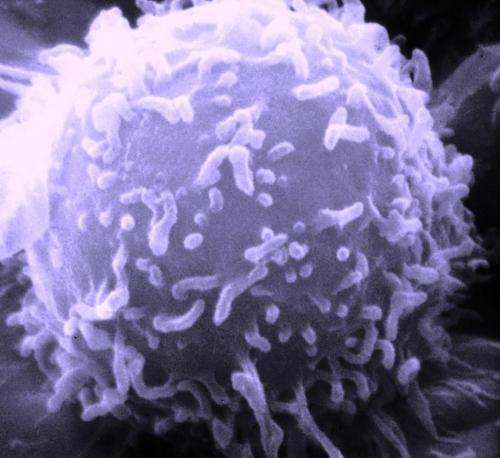January 26, 2016 report
Optically active nanoparticles serve as cancer drug indicators

(MedicalXpress)—Researchers from Ohio State University have designed nanoparticles based on naturally occurring green fluorescent proteins that can trace the progression of a cancer drug through human cells. These nanoparticles are optically active in the visible range, biocompatible, photostable, and initial studies in which these nanoparticles were functionalized with MUC1 aptamer – doxorubicin (DOX), a complex that is used to take chemotherapeutic DOX to cancer cells – showed that they are able to monitor drug release in real time in human carcinoma epithelial cells. Their work appears in Nature Nanotechnology.
Zhen Fan, Leming Sun, Yujian Huang, Yongzhong Wang, and Mingjun Zhang modeled their dipeptide nanoparticle (DNP) after yellow fluorescent protein whose optical activity is due to pi-pi stacking and BFPms1, a mutant green fluorescent protein whose coordinated Zn(II) complex promotes greater fluorescent intensity. They investigated various combinations of the three aromatic peptides, tryptophan, phenylalanine, and tyrosine, and found that the Zn(II) coordinated Trp-Phe complex readily self-assembled into nanoparticles and was optically active within a narrow visible range.
After investigating the optical activity of analogous complexes using alkali and alkali-earth ions, Zhen, et al. confirmed that transition metals form the best coordination structure. Additionally, they investigated the optimal concentration, temperature, and pH range for the best optical signal for their DNP. Fluorescence studies showed that the DNPs emit a bright blue color, and have a narrower emission bandwidth compared to Trp-Phe monomers. Comparative studies with an organic fluorescent dye (rhodamine 6G) confirmed that the DNPs were photostable, and in vitro studies with NIH-3T3 cells demonstrated that the DNPs were biocompatible compared to CdSe quantum dots.
DNPs were functionalized with MUC1 aptamer, oligonucleotides that target cancer cells in which the MUC1 proteins are overexpressed. Zhen, et al. then compared the MUC1 aptamer functionalized DNP in mouse fibroblast cells that are MUC1-negative to human carcinoma cells that are MUC1-positive to determine if it they are selective for MUC1-positive cells. They found that the human cells showed significant fluorescence while the mouse cells did not.
Finally, DOX, a chemotherapeutic drug, tends to stack with aromatic DNPs. Dox was conjugated with the Trp-Phe DNP and studies showed that, when conjugated, the complex shows fluorescence quenching and diminished absorbance. Studies with human carcinoma cells showed that as DOX is released into the target cell, the DNP's fluorescence signal increases providing a real-time optical indicator for cancer drug release.
One of the goals of precision medicine is to understand why different people respond differently to the same cancer therapy. This study provides a way to monitor the path of a well-known cancer therapeutic as it is released in the target cells. The hope is that this will eventually help researchers optimize therapies for the individual patient.
More information: Zhen Fan et al. Bioinspired fluorescent dipeptide nanoparticles for targeted cancer cell imaging and real-time monitoring of drug release, Nature Nanotechnology (2016). DOI: 10.1038/nnano.2015.312
Abstract
Peptide nanostructures are biodegradable and are suitable for many biomedical applications. However, to be useful imaging probes, the limited intrinsic optical properties of peptides must be overcome. Here we show the formation of tryptophan–phenylalanine dipeptide nanoparticles (DNPs) that can shift the peptide's intrinsic fluorescent signal from the ultraviolet to the visible range. The visible emission signal allows the DNPs to act as imaging and sensing probes. The peptide design is inspired by the red shift seen in the yellow fluorescent protein that results from π–π stacking and by the enhanced fluorescence intensity seen in the green fluorescent protein mutant, BFPms1, which results from the structure rigidification by Zn(II). We show that DNPs are photostable, biocompatible and have a narrow emission bandwidth and visible fluorescence properties. DNPs functionalized with the MUC1 aptamer and doxorubicin can target cancer cells and can be used to image and monitor drug release in real time.
© 2016 MedicalXpress

















